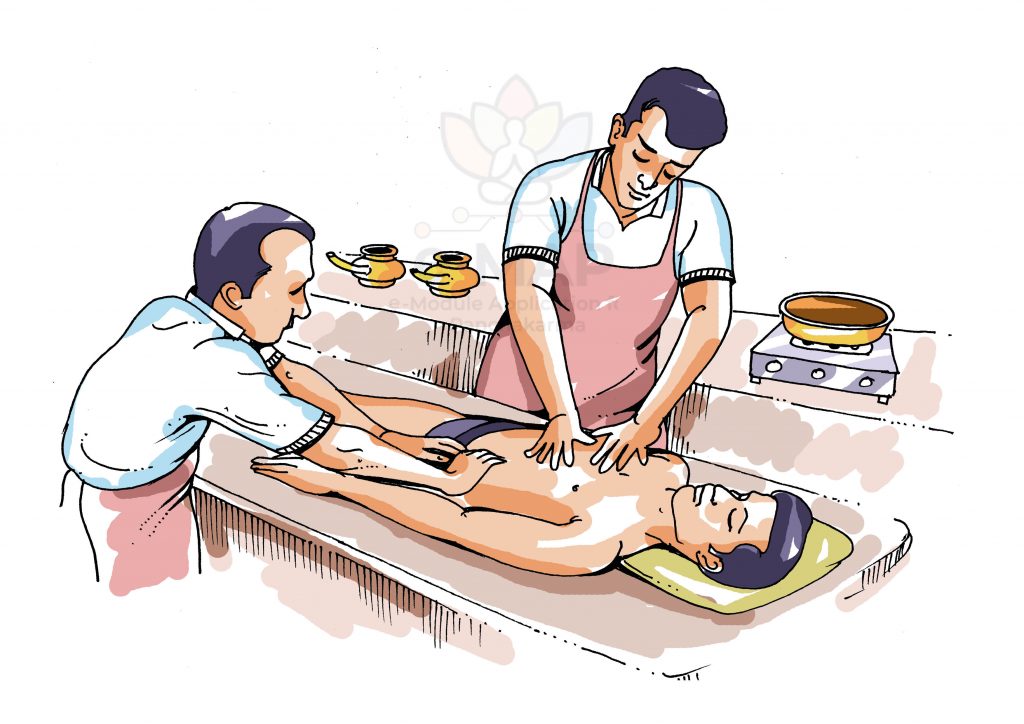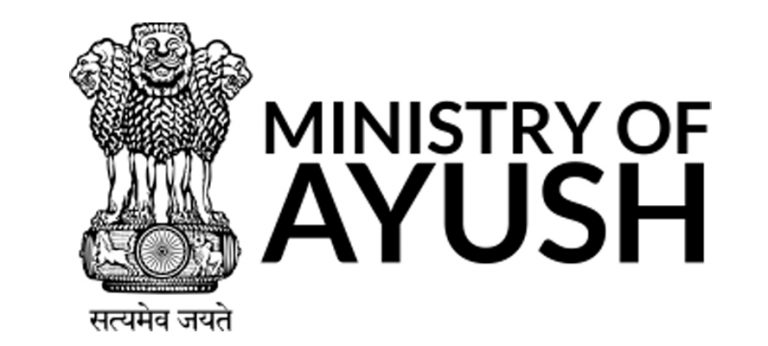
Intense Module 1
Introduction

EXPLANATORY NOTES
Pañcakarma plays a vital role because of the fast relief it provides by expelling out the toxins from the body in a proper way detoxifying the body.Pañcakarma is the ultimate Ayurvedic detoxification of body. It also maintains balances of Doṣas, digestive fire, life span, immune status, health conditions & many other factors.[i]
Importance in Dinacarya
In Dinacarya various procedures like Snehana, Abhyaṅga, Udvartana, Śiro Abhyaṅga, Pratimarśa Nasya, Pādābhyaṅga etc… are told which helps in promotion of the health in Svastha persons. Pratimarśa Nasya has been told in different Kāla in a day. Similarly, Dhūma has been also told. By regularly following all these procedures the person becomes Svastha, Balavān and Sudṛḍha.
Importance in Ṛtucarya and Śodhana according to Ṛtu
The Doṣas get accumulated in the body gradually over Ṛtus which should be eliminated for keeping the body Svastha. Ācāryas have specified elimination or Śodhana of Doṣas in specific Ṛtus like in Prāvṛṭ Ṛtu Basti should be administered to normalise the aggravated Vāta, similarly in Śarat Ṛtu, Virecana should be done to normalise the aggravated Pitta and in VasantaṚtu Vamana should be done to eliminate the aggravated Kapha.
अत्युष्णवर्षशीता हि ग्रीष्मवर्षाहिमागमाः|
तदन्तरे प्रावृडाद्यास्तेषां साधारणास्त्रयः||
प्रावृट् शुचिनभौ ज्ञेयौ शरदूर्जसहौ पुनः|
तपस्यश्च मधुश्चैव वसन्तः शोधनं प्रति||
एतानृतून् विकल्प्यैवं दद्यात् संशोधनं भिषक्|
स्वस्थवृत्तमभिप्रेत्य व्याधौ व्याधिवशेन तु||[ii]
Grīṣma(Summer), Varṣa(Rainy Season) and Himāgamaor Hemanta (Winter) are charecterized by excessive heat, rain and cold respectively. The three intervening seasons viz, Prāvṛṭ (the period between summer and rainy season), Śarat or Autumn (the period between rainy season and winter) and Vasanta or spring (the period between winter and summer) are of general nature.
The months composing the three seasons of general nature are as follows
Prāvṛṭ (approx. June – August) |
Sūci – Nabha |
Āṣāḍha –Śrāvaṇa |
Vāta Śodhanārtha – Basti |
Śarat (approx. October- December) |
Ūrja– Saha |
Kārttikā –Mārgaśīrṣa |
Pitta Śodhanārtha – Virecana |
Vasanta (approx. February– April) |
Tapasya–Madhu |
Phālguna – Caitra |
Kapha Śodhanārtha- Vamana |
The above mentioned three seasons are suitable for the administration of elimination therapies.
After determining the exact months constituting the above-mentioned seasons, the physician should give appropriate elimination therapies to a healthy person. However, for a patient, the appropriateness of the time (season) should be determined on the basis of the nature of the diseases.
आत्ययिके पुनः कर्मणि काममृतुं विकल्प्य कृत्रिमगुणोपधानेन यथर्तुगुणविपरीतेन भेषजं संयोगसंस्कारप्रमाणविकल्पेनोपपाद्य प्रमाणवीर्यसमं कृत्वा ततः प्रयोजयेदुत्तमेन यत्नेनावहितः|| [iii]
Caraka in Vimāna Sthāna says in emergency conditions Pañcakarma can be done in any season by creating artificial environment and by administering the drug which has been potentiated by combining with other drugs.
Śodhana in Treatment of Diseases
There are three methods of treatment told for the removal of diseases according to Caraka in Vimāna sthāna – Śodhana, Śamana and Nidāna Parivarjana
संशोधनं संशमनं निदानस्य च वर्जनम्|
एतावद्भिषजा कार्यं रोगे रोगे यथाविधि||३०||[iv]
Ācāryas have told that in different kinds of Roga the treatment should be finalised only after assessing Prakṛti of the patient, Sāra, Bala, Vaya, Satva, Sātmya and Jataragni. The diseases which are cured by Śodhana does not re- occur again. In Prameha, Kuṣṭha, Pāṇḍu, VātaVyādhi, Vātarakta, Rājayakṣmā, Manovikāra different procedures like Vamana, Virecana, Basti, Nasya, Raktamokṣa etc. are told. Further the detailed Pañcakarma procedures are elaborated in their respective Cikitsādhikāra.
Importance in Vegadhāranajanya Roga
Ācāryas have specified the use of Pañcakarma procedures and Bāhya Karmas in the treatment of Vegadhāranajanya Roga. In Mūtra Vegadhāranajanya Roga treatment procedures like Avagāha Sveda, Abhyaṅga, Basti Karma and in Purīṣa Vegadhāranajanya Roga Avagāha Sveda, Basti karma, Varti Prayoga etc. are told.
[i]http://ccras.nic.in/content/importance-panchkarma-improving-general-health
[ii]Cha. Si 6/4
[iii]Cha. Vi 8/128
[iv]Cha. Vi 7/30
In this topic we can see the various Auṣadha Yogas used in different parts of the treatment.
DĪPANA–PĀCANA YOGAS
For Dīpana – Pācana we can use different Auṣadha Yogas like
- Trikaṭu Cūrṇa / Tryūṣaṇa Cūrṇa
Śuṇṭhī, Marica, Pippali
- Pañcakola Cūrṇa
Pippali, Pippalīmūla, Cavya, Citraka, Nagara
- Hiṅgvāṣṭaka Cūrṇa
Trikaṭu, Ajamoda, Saindhava, JīrakaDvaya – Kṛṣṇa and Śveta, Hingu and Ghee
- Śivākṣara Pācana Cūrṇa
Trikaṭu, Ajamoda, Saindhava, Jīraka, KṛṣṇaJīraka, Hingu, Harītakī, SarjaKṣāra
- Citrakādi Vaṭī
Chitraka, Pippalīmūla, YavaKṣāra, SvarjikaKṣāra, Sauvarcala, Saindhava, Viḍa, Sāmudra and Audbhida Lavaṇa, Śuṇṭhī, Marica, Pippali, Hingu, Ajamoda, Cavya and Mātuluṅga Svarasa.
GHṚTA YOGAS
- Tiktaka Ghṛta
- Mahātiktaka Ghṛta
- Āragvadha Mahātiktaka Ghṛta
- Amṛtaprāśa Ghṛta
- Bhallātaka Ghṛta
- Brahmī Ghṛta
- BṛhatyādiGhṛta
- DadhikāGhṛta
- DāḍimādiGhṛta
- DhānvantaraGhṛta
- DhātryādiGhṛta
- DrākṣādiGhṛta
- GrahaṇyāntakaGhṛta
- GugguluTiktakaGhṛta
- IndukāntamGhṛta
- JīvantyādiGhṛta
- KalyāṇakaGhṛta
- KaṇṭakārīGhṛta
- MahāKalyāṇakaGhṛta
- PañcagavyaGhṛta
- TriphalaGhṛta
- SārasvataGhṛta
- ṢaṭpalaGhṛta
- SukumāraGhṛta
- VaruṇādiGhṛta
- VidāryādiGhṛta
TAILA YOGAS
- MūrcchitaTilaTaila
- JīvantyādiTaila
- PippalyādiTaila
- MahānārāyaṇaTaila
- NārāyaṇaTaila
- MahāmāṣaTaila
- MadhuyaṣṭyādiTaila
- SahacarādiTaila
- DaśamūlaTaila
- CandanabalālākṣādiTaila
- BalāTaila
- KṣīrabalāTaila
- JatyādiTaila
- DhānvantaramTaila
- BṛhatSaindhavādiTaila
- BalāGuḍūcyādiTaila
- AṇuTaila
- ṢaṭbinduTaila
- AmṛtādiTaila
- ApāmārgaKṣāraTaila
- ArimedādiTaila
- Asana ElādiTaila
- Asana BilvādiTaila
- Asana MañjiṣṭhādiTaila
- HimasāgaraTaila
- CandanādiTaila
- BalāhaṭhādiTaila
- BhṛṅgāmalakiTaila
- BhṛṅgarājaTaila
- DhurdhuraPatrādiTaila
- DineśavallyādiTaila
- DūrvādiKera
- EladiGaṇaTaila
- GandhaTaila
- KārpāsāsthyādiTaila
- KarpūrādiTaila
- PrasāriṇyādiTaila
- KetakīmūlādiTaila
- KottamchukkadiTaila
- KuṅkumādiTaila
- PiṇḍaTaila
- NalpāmarādiTaila
- MaricādiTaila
- NimbāmṛtaEraṇḍaTaila
- SindhuvāraEraṇḍaTaila
- GandharvaEraṇḍaTaila
- TriphalādiTaila
- ViṣagarbhaTaila
- PañcaguṇaTaila
VIRECANA YOGAS
Avipatti Cūrṇa[i]
Mostly used in South India
Ingredients are Trikaṭu, Tvak, Patra, Ela, Ambhoda (Musta), Viḍaṅga, Āmalaki, Trivṛt, Sugar. Sugar Should be taken in equal quantity to that of the other ingredients in total.
व्योषत्रिजातकाम्भोदकृमिघ्नामलकैस्त्रिवृत्|सर्वैः समा समसिता क्षौद्रेण गुटिकाः कृताः|
मूत्रकृच्छ्रज्वरच्छर्दिकासशोषभ्रमक्षये|तापे पाण्ड्वामयेऽल्पेऽग्नौ शस्ताः सर्वविषेषु च|
अविपत्तिरयं योगः प्रशस्तः पित्तरोगिणाम्||[ii]
Avipattikara Cūrṇa[iii]
Mostly used in North India.
Ingredients are Trikaṭu, Triphala, Musta, ViḍaLavaṇa, Viḍaṅga, Ela, Patra, Lavanga, Trivṛt and Sugar.
The proportion of Lavanga, Trivṛt and Sugar are different in both Yogas.
Icchābhedi Rasa[iv]
Ingredients are Śuṇṭhī, Marica, ŚuddhaPāradaand Gandhaka,ṬaṅkaṇaBhasma and ŚuddhaJayapāla
Abhayādi Modaka[v]
Abhaya, Maricha, Śuṇṭhī, Viḍaṅga, Āmalaki, Pippali, Pippalīmūla, Tvak, Patra, Musta, Dantī, Trivṛt, śarkara, Madhu
Trivṛt Leha
त्रिवृत्कल्ककषायाभ्यां साधितः ससितो हिमः
मधुत्रिजातसंयुक्तो लेहो हृद्यं विरेचनम्|[vi]
Eraṇḍa Taila
कटूष्णं तैलमैरण्डं वातश्लेष्महरं गुरु |
कषायस्वादुतिक्तैश्च योजितं पित्तहन्त्रपि[vii]
Other VirecakaYogas include
- GandharvahastadiEraṇḍaTaila
- NimbāmṛtaEraṇḍaTaila
- SindhuvāraEraṇḍaTaila
- RecakaVaṭī
- KalyāṇakaGuda
- MāṇibhadraGuda
- MiśrakaSneha
UPAGA GAṆA
These are explained in CarakaSūtrasthāna4th chapter [viii]
Snehopaga Gaṇa
मृद्वीकामधुकमधुपर्णीमेदाविदारीकाकोलीक्षीरकालोलीजीवकजीवन्तीशालपर्ण्य इति दशेमानि स्नेहोपगानि भवन्ति
Svedopaga Gaṇa
शोभाञ्जनकैरण्डार्कवृश्चीरपुनर्नवायवतिलकुलत्थमाषबदराणीति दशेमानि स्वेदोपगानि भवन्ति
Vamanopaga Gaṇa
मधुमधुककोविदारकर्बुदारनीपविदुलबिम्बीशणपुष्पीसदापुष्पाप्रत्यक्पुष्पा इति दशेमानि वमनोपगानि भवन्ति
Virecanopaga Gaṇa
द्राक्षाकाश्मर्यपरूषकाभयामलकबिभीतककुवलबदरकर्कन्धुपीलूनीति दशेमानि विरेचनोपगानि भवन्ति
Asthāpanopaga Gaṇa
त्रिवृद्बिल्वपिप्पलीकुष्ठसर्षपवचावत्सकफलशतपुष्पामधुकमदनफलानीति दशेमान्यास्थापनोपगानि भवन्ति
Anuvāsanopaga Gaṇa
रास्नासुरदारुबिल्वमदनशतपुष्पावृश्चीरपुनर्नवाश्वदंष्ट्राग्निमन्थश्योनाका इति दशेमान्यनुवासनोपगानि भवन्ति
Śirovirecanopaga Gaṇa
ज्योतिष्मतीक्षवकमरिचपिप्पलीविडङ्गशिग्रुसर्षपापामार्गतण्डुलश्वेतामहाश्वेता इति दशेमानि शिरोविरेचनोपगानि भवन्ति
[i]SahasrayogaCūrṇa Prakarana
[ii]A.H. Kalpa 2/21
[iii]Bhai. Rat. Amlapitta 25
[iv]Bhai. Rat. Udararoga 13 – 105
[v] Sha. Sam U 4/26
[vi]A. H. Kalpa 2/9
[vii]Cha. Su 13/ 12
[viii]Cha. Su 4/ 21-27
Ācāryās have given importance to Āhāra in the Pūrva Karma, Pradhāna Karma and Paścāt Karma. Just like Auṣadha is important in treatment, Āhāra is also important.
The three important parts of Āyurveda science are the Ausadha (medicine), Āhāra(diet), and Vihāra (work out, exercise etc). Āhāra Kalpanā is one of the important parts. All detail like ingredients-preparative method. Quantity of prepared formulation has been carefully mentioned in Āyurveda. The precisely constituted, calculated and cooked food is known as Pathya (ideal food) to be useful for good health.
All detail like ingredients, preparative method, quantity of prepared formulation has been carefully mentioned in Āyurveda. The precisely constituted, calculated and cooked food is known as Pathya (ideal food) to be useful for good health. In Āyurveda according to ĀcāryāKaśyapa the diet (Āhāra) is known as Mahābheṣaja(supreme medicine)
Use of Kalpanā with consideration of otherelements makes the Dravyas suitable forhuman body. The Āhāra Vargas like Śūka Dhānya (cereal grains), Śamī Dhānya(legumes), Māṃsa (meat) and Śākā(vegetables) cannot be used without applying Kalpanā.
So that in Bṛhattrayī all three Ācāryās have mentioned Kṛtānna Vargas to explain the different Kalpanās made by Dravyas of other Āhāra Vargas. In other words, KṛtānnaVarga/ Āhāra Kalpanā is applied aspect of described Āhāra Vargas. It consists of prepared foods, methods of preparing of different type of food items like Maṇḍa, Peya, Yavāgu, Anna, Vilepī, Yūṣa, Kṛśara, Saktu (floor of Roasted paddy) etc with their method of preparations and properties[i]
In Āyurveda Āhāra Kalpanās are mentioned in various places. Here we look into the Āhāra Kalpanās relevant to Pañcakarma like in Saṃsarjana Krama, Pravicāraṇa Sneha, Pathya Āhāra to be followed after Pañcakarma etc.
ĀHĀRA KALPANĀS IN SAṂSARJANA KRAMA
We know there are Peyādi and Tarpaṇādi Saṃsarjana Krama. We need to know how these are prepared and what are the references in various Samhitas for the same. Saṃsarjana Krama or the restricted diet or the order by which Ācāryā have carefully placed light food to heavy food (Peya to Māṃsarasa) is a matter of discussion.
PEYĀDI SAṂSARJANA KRAMA
पेयां विलेपीमकृतं कृतं चयूषं रसं त्रीनुभयं तथैकम्|
क्रमेण सेवेत नरोऽन्नकालान्प्रधानमध्यावरशुद्धिशुद्धः|[ii]
After Śodhana Karma the patient should be given Peyādi Saṃsarjana Krama ie; Peya (thin gruel) Vilepī (thick gruel), akṛta and kṛta–Yūṣa and Māṃsarasa (seasoned and unseasoned vegetable soup and meat soup).
PEYA
पेया सिक्थयुता सिद्धा चतुर्दशगुणेऽम्भसि [iii]
Rice is cooked by adding 14 times of water and boiled till it is dissolved to become liquid or thin gruel is Peya
सिक्थैर्विरहितो मण्डः पेया सिक्थसमन्विता
विलेपी बहुसिक्था स्याद्यवागूर्विरलद्रवा[iv]
Peya Guṇa
पेया लघ्वी हिता ग्लानिपिपासाक्षुच्छ्रमप्रणुत् | स्तम्भातिसारदौर्बल्यकुक्षिरोगज्वरापहा
दीपनी पाचनी दोषमलस्वेदानुलोमनी |[v]
क्षत्तृष्णाग्लानिदौर्बल्यकुक्षिरोगज्वरापहामलानुलोमनी पथ्या पेया दीपनपाचनी|[vi]
Peya is Laghu, good for health, removes tiredness, Pipasā, Glāni, Kṣut, Śrama and Stambha. It is good in conditions like Atisāra, Daurbalya, Kukṣi Roga and Jvara. It is Dīpana, Pācana and Anulomaka.
VILEPĪ
विलेपी घनसिक्था स्यात् सिद्धा तोये चतुर्गुणे[vii]
Rice cooked by adding 4 times water till it become semi – liquid or thick gruel.
VilepīGuṇa
विलेपी दीपनी हृद्या ग्राहिणी क्षुततृषापहा |
लघ्वी स्वादुरसा नित्यं स्नेहनायोपयोगिनी
बल्या सन्तर्पणी पथ्या व्रणशुक्राक्षिरोगिणे [viii]
Vilepī is Agni Dīpaka, Hṛdya and Grāhī. It removes Kṣūdhā and Tṛṣṇā. It is Laghu, Madhura, good during Snehana, Balya and Santarpaṇa.
विलेपी ग्राहिणी हृद्या तृष्णाघ्नी दीपनी हिता|व्रणाक्षिरोगसंशुद्धदुर्बलस्नेहपायिनाम्|[ix]
YŪṢA
18 times water added to any one of the pulses and is cooked properly so that it contains more liquid and less solid.
अष्टादशगुणे तोये शृतो यूषस्तु शिम्बिजैः सः स्यात् कृताख्यो लवणकटुस्नेहादिसंयुतः
अकृताख्यस्तद्रहितः क्रमाद् गुरुलघू मतौ[x]
When it is prepared without adding Lavaṇa, Sneha, Śuṇṭhī or any other spices it is termed as Akṛta Yūṣa and when prepared by adding Lavaṇa, Sneha, Śuṇṭhī or any other spices is called Kṛta Yūṣa.
अस्नेह लवणं सर्वमकृतं कटुकै: विनाविग्येयं लवण स्नेह संस्कृतं कृतं इति [xi]
Mudga is Madhura Rasa, Laghu Rūkṣa Guṇa, Śīta Vīrya and it has Kapha Pittahara Property.
MudgaYūṣaGuṇa
कफघ्नो दीपनो हृद्यः शुद्धानां व्रणिनामपि ज्ञेयः पथ्यतमश्चैव मुद्गयूषः कृताकृतः[xii]
मौद्गस्तु पथ्यः संशुद्धव्रणकण्ठाक्षिरोगिणाम्[xiii]
Mudga Yūṣa is the best among Yūṣa. It is Dīpana, Hṛdya good for those undergone Śodhana, good in Vraṇa. Kayyadeva says it is Laghu, Śītala, good in Ūrdhvajatru Vikāra. It is good in Kapha, Pitta and Rakta vitiated conditions.
MĀṂSA RASA
Clean meat is cut into small pieces and taken in twice the quantity of Auṣadha Dravya and boiled in 18 times water and reduced to 1/4th.
When it is prepared without adding Lavaṇa, Sneha, Śuṇṭhī or any other spices it is termed as Akṛta Māṃsa Rasa and when prepared by adding Lavaṇa, Sneha, Śuṇṭhī or any other spices is called Māṃsa Rasa.
स्नेहाम्लकटुसिन्धूत्थरामठादिकसंयुताः रसादयः कृता ज्ञेयास्त्वकृतास्तद्विवर्जिताः[xiv]
Māṃsa Rasa Guṇa
बृंहणः प्रीणनो वृष्यश्चक्षुष्यो व्रणहां रसः[xv]
MāṃsaRasa is Bṛṃhaṇa, Prīṇana,Vṛṣya, Cakṣuṣya and Vraṇahara.Kayyadeva saysAjamāṃsaalleviates Tridoṣaand is Guru, PīnasaNāśana, easily digestible, not too Śīta, not too Snigdha, does not cause Dāha, good for Dhātus and is not Abhiṣyandi.
अनुष्णवीर्यं पित्तघ्नं घृतसिद्धं मनोहरम् दृष्टिप्रसादनं हृद्यं रुच्यं लघ्वग्निदीपनम् |[xvi]
TARPAṆĀDISAṂSARJANA KRAMA
- लाजा सक्तुं पिबेदादौ ततो यूषान्न भोजनम्पश्चात् मांसरसान्नं स्यात् तर्पणादि क्रमो हित:
- तर्पणादिक्रमे च पेयायाः स्थाने स्वच्छतर्पणं, विलेप्याः स्थाने च घनतर्पणं देयम्[xvii]
Instead of Peya – SvacchaTarpaṇa (light) and instead of Vilepī – Ghana Tarpaṇa (thick) are advised followed by Kṛta and AkṛtaYūṣa and Māṃsarasa.
- SvacchaTarpaṇa – 1-part Lāja (parched paddy) cooked in 14 parts of water
- Ghana Tarpaṇa – 1-part Lāja (parched paddy) cooked in 4 parts of water
LājaGuṇa
Properties of Lāja are Kaṣāya, Madhura Rasa, LaghuGuṇa and ŚītaVīrya.
भृष्टशाल्यादिजा लाजा धाना भृष्टयवादिजाः लाजाः कषाया मधुराः दीपना लघवो हिमाः |
बल्यास्तृट्छर्द्यतीसारमेहमेदःकफच्छिदः दाहकासास्रपित्तेषु हिताः स्वल्पमलप्रदाः | [xviii]
Lāja is Balya, cures Tṛṣṇā, Atisāra, Carddhi, Meha, Medas, KaphaNāśana. It is useful in Dāha, Kāsa, Raktapittaand is alsoAlpaMalaprada.
A different but scientific concept of Saṃsarjana Krama is given by ĀcāryāKaśyapa[xix]
- First meal after Saṃśodhana– AparāhnaKāla(in evening) – MaṇḍaPradhānaYavāgu is given prepared from boiling of year old Raktaśālī, Trisūtratā(filtered thrice) as digestive juices are not secreted enough to digest solid particles of food), processed with DīpanīyaDravya and Lavaṇa (assist digestion), should be Rūkṣa and utensil to serve it should be clean and attractive (serve as to induce appetite). It should be served warm, fresh and properly prepared.
- 2nd day =Yavāgu
- 3rd day = Rūkṣa and UṣṇaVilepī prepared with DīpanīyaDravya, SaindhavaLavaṇa is served.
- 4th day = AkṛtaMudgaMaṇḍa with Odana (indicated for Kṛśaperson) (Maṇḍa is prepared from old Raktaśālī, Bhṛṣṭa(Baked) and Nistuṣa(Without husk) Mudga
- 5th day = MudgaMaṇḍa with Odana mixed with Īṣatā Amla Phala
- 6th, 7th day = KṛtaMudgaMaṇḍa with Odana with Amla Phala + Sneha Dravya
- 8th day = TanuKṛtaMāṃsarasa with Odana
- 9th day = ĪṣatāKṛtaMāṃsarasa with Odana + Sneha
- 10th day, 11th day = KṛtaMāṃsarasa with Odana + Sneha + Amla Phala + Lavaṇa
- 12th day = Normal diet, digestive capacity is fully regained.
ĀHĀRAKALPANĀS IN PRAVICĀRAṆA SNEHA
ओदनश्च विलेपी च रसो मांसं पयो दधि| यवागूः सूपशाकौ च यूषः काम्बलिकः खडः
सक्तवस्तिलपिष्टं च मद्यं लेहास्तथैव च| भक्ष्यमभ्यञ्जनं बस्तिस्तथा चोत्तरबस्तयः
गण्डूषः कर्णतैलं च नस्तःकर्णाक्षितर्पणम्| चतुर्विंशतिरित्येताः स्नेहस्य प्रविचारणाः [xx]
There are 24 kinds of Pravicāraṇa Sneha told in CarakaSnehādhyāya. The various ĀhāraKalpanās told in this is discussed below.
- Odana – Cooked rice
- Vilepī – Gruel
- Rasa – MeatSoup
- Māṃsa – Meat
- Paya – Milk
- Dadhi – Curd
- Yavāgu – Gruel
- Sūpa – Vegetable Soup
- Śākā – PreparedVegetables
- Yūṣa – Soup prepared with Mudga
- Kāmbalikā – Sour Preparation
- Khaḍa – Buttermilk processed with Vegetables and Spices
- Saktu – Roasted Paddyflour
- TilaPiṣṭa – Sesame Cake
- Madhya –Fermented alcoholic drinks
- Leha – Linctus
- Bhakṣya– Food Items
ODANA
अन्नं पञ्चगुणे तोये[xxi]
Odana is prepared by adding rice and 5- times water according to Suśruta.
Preparation should be done in 10 – times Jala according to Kayyadeva
सिद्धं दशगुणे तोये तण्डुलेभ्यः परिस्रुतम् |
भक्तमन्नं कूरमन्धो भिस्सा दीदिविरोदनः [xxii]
Synonyms of Odana includes Anna, Bhakta, Krūra, Bhissā etc. Different varieties of Odana are mentioned in KayyadevaNighaṇṭuKṛtānnaVarga.
According to Śāraṅgadhara4 Pala rice is boiled in 14 times water and prepared and the watery part is removed taking only the Odana. This Preparation is Madhura and Laghu.
Types of Odana
According to Suśruta there are two types of Odana
- SudhautaPrasruta
धौतस्तु विमलः शुद्धो मनोज्ञः सुरभिः समः || स्विन्नः सुप्रस्रुतस्तूष्णो विशदस्त्वोदनो लघुः |[xxiii]
- AdhautaPrasruta
अधौतोऽप्रस्रुतोऽस्विन्नः शीतश्चाप्योदनो गुरुः |[xxiv][xxv]
According to KaśyapaOdana is Viśada and should be devoid of Maṇḍa and is Mṛdu.
MĀṂSA
There are 6 MāṃsaVarga according to Suśruta which are UttarottaraGuṇādhikya.
तद्यथा- जलेशया, आनूपा, ग्राम्याः, क्रव्यभुज, एकशफा, जाङ्गलाश्चेति षण्मांसवर्गा भवन्ति |एतेषां वर्गाणामुत्तरोत्तरा प्रधानतमाः ते पुनर्द्विविधा जाङ्गला आनूपाश्चेति |तत्र जाङ्गलवर्गोऽष्टविधः |तद्यथा- जङ्घाला, विष्किराः, प्रतुदा, गुहाशयाः, प्रसहाः, पर्णमृगा, बिलेशया, ग्राम्याश्चेति तेषां जङ्घालविष्किरौ प्रधानतमौ [xxvi]
Another classification of MāṃsaVarga is based on Sthāna – Jāṅgalaand Ānūpa
In Aṣṭāṅgahṛdaya8 MāṃsaVarga are told. They are MṛgaVarga, ViṣkiraVarga, PratudaVarga, VileśayaVarga, PrasahaVarga, MahāMṛga, Apcarās and MatsyaVarga.
KṢĪRA
स्वादुपाकरसं स्निग्धमोजस्यं धातुवर्धनम्
वातपित्तहरं वृष्यं श्लेष्मलं गुरु शीतलम्| [xxvii]
Milk in general is Madhura in Rasa and Vipāka, is Snigdha, increases Ojas and Dhātus, pacifies Vāta and Pitta, is Vṛṣya, increases Kapha and is Guru and Śīta.
तर्पणं प्रीणनं मेध्यं मधुरं रसपाकयोः | बल्यं रसायनं वर्ण्यं श्लेष्मलं धातुवर्धनम्
ओजस्यं पिच्छिलं स्निग्धं स्तन्यदं शीतलं गुरु | निर्वापणमभिष्यन्दि रक्तपित्तानिलापहम् ||
सात्म्यं प्राणभृतां प्रायः शुक्रवर्धनरेचनम् [xxviii]
There are references about the qualities of different kinds of milk like Gokṣīra, MāhiṣaKṣīra, Ajākṣīra, UṣṭraKṣīra, MānuṣaKṣīra, HasthiKṣīra in various places. The milk which has to be used in treatment depends on the condition of the patient and the Doṣa predominance.
पयोऽभिष्यन्दि गुर्वामं, युक्त्या शृतमतोऽन्यथा भवेद्गरीयोऽतिशृतं, धारोष्णममृतोपमम्| [xxix]
Unboiled milk is Abhiṣyandi and is Guru, but when properly boiled, has opposite properties. Condensed milk is much more Guru. Milk that is freshly drawn resembles divine elixir in properties.
DADHI
अम्लपाकरसं ग्राहि गुरूष्णं दधि वातजित्||मेदःशुक्रबलश्लेष्मपित्तरक्ताग्निशोफकृत्|
रोचिष्णु शस्तमरुचौ शीतके विषमज्वरे||पीनसे मूत्रकृच्छ्रे च, रूक्षं तु ग्रहणीगदे|[xxx]
Curd is Amla in Rasa and Vipāka. It is Grāhī, Guru, Uṣṇa and pacifies Vāta. It increases Medas, Śukra, Bala, Kapha, Rakta, Pitta, Agni and Śopha. It is delicious and cures Aruci, ŚītaJvara, ViṣamaJvara, VātikaPīnasaand Mūtrakṛcchra. It is used in GrahaṇīRoga.
Rules of using Dadhi
नैवाद्यान्निशि नैवोष्णं वसन्तोष्णशरत्सु न||नामुद्गसूपं नाक्षौद्रं तन्नाघृतसितोपलम्|
न चानामलकं नापि नित्यं नो मन्दमन्यथा||ज्वरासृक् पित्तवीसर्पकुष्ठपाण्डुभ्रमप्रदम्|
Don’t use curd
- In the night
- After heating
- In Spring, Summer and Autumn
- Should not be taken without green gram soup, honey, ghee, sugar or Āmalaki
- Should not be constantly used
It will causeJvara, Raktapitta, Visarpa, Kuṣṭhaand Pāṇḍu
YAVĀGU
सिक्थैर्विरहितो मण्डः पेया सिक्थसमन्विता
विलेपी बहुसिक्था स्याद्यवागूर्विरलद्रवा[xxxi]
In Yavāgu the quantity of Jala is less.
यवागूं षड्गुणे पचेत्[xxxii]
One part of rice is boiled in 6 times water and Yavāgu is prepared. After preparation the quantity of water is less and SiktaBhāgais more.
YavāguGuṇa
According ŚāraṅgadharaGrāhī, Balya, Tarpaṇa, Vātanāśaka[xxxiii]
YavāguDoṣa
According to Kaśyapa there are 7 Doṣas. Ghana, Viśīrṇa, Śīta, Less rice, Picchila, Viśada, Ahṛdya[xxxiv]
SŪPA
One part of Pulsesis boiled in 14- or 18-times water and reduced to 1/4th.
SūpaGuṇa
रूक्षा विष्टम्भिनः सूपा निरम्लास्तु विशेषतः सूपं लघु जरां याति भृष्टस्विन्नं तुषैर्विना |
काञ्चनाख्यः श्लेष्मपित्तकासश्वासहरो लघुः प्रहिताख्यः मनाक्भृष्टः सुस्विन्नो निष्तुषो लघुः |
माषसूपं भृष्टमपि गुरुमूचुः परे लघुम् | [xxxv]
ŚĀKĀ
शाकं पाठाशठीसूषासुनिषण्णसतीनजम्| त्रिदोषघ्नं लघु ग्राहि सराजक्षववास्तुकम्|[xxxvi]
Made with Phala (fruit form of vegetables), Puṣpa (flowering vegetables), Patra (leafy vegetables), Nāla(hollow vegetables), Kanda (tuberous vegetables) and Saṃsvedaja(grows with the help of moisture in Bhūmīor wood) of VanaspatīDravya.The following are some examples
PhalaŚākā | Kūśmāṇḍa, Karkaṭī, Kāravellaka, Paṭola, Śophāñjana |
PuṣpaŚākā | KadalīPuṣpa |
PatraŚākā | Upodika, Pālākhya,Dhānyaka, Methika |
NaalaŚākā | Sarṣapa |
KandaŚākā | Soorana, Laśuna, Palaṇḍu, Mūlaka |
Samswedaja | Chatraka |
KHAḌA – KĀMBALIKĀ
These two are the special preparations of Yūṣa prepared by Takraand any DhānyaViśeṣa.
Kāmbalikā
In One-partDadhiMastu 1/8th part Moong Dal is added and boiled and reduced to half. Into this SauvarcalaLavaṇa, Sveta Jīraka, Nimbu Rasa and SugandhaDravyaare added and Kāmbalikā is made.
Khaḍa
There are two types of Khaḍa
- SatakraŚimbīDhānya – One-partTakra and 1/6thpart ŚimbīDhānya are boiled and reduced to half or one fourth. Add Ghṛta, Saindhava, Lavaṇa, Jīraka, Śuṇṭhī, Marica etc… into this.
- SatakraŚākā -One-part Takra and 1/6thpart Śākā like Kapitha, Cārṅgerīare boiled and reduced to half or one fourth. Add Jīraka, Marica and Saindhava in required quantity.
Khaḍa – KāmbalikāGuṇa
खडकाम्बलिकौ हृद्यौ तथा वातकफे हितौबल्यः कफानिलौ हन्ति दाडिमाम्लोऽग्निदीपनः
दध्यम्लः कफकृद्बल्यः स्निग्धो वातहरो गुरुः | तक्राम्लः पित्तकृत् प्रोक्तो विषरक्तप्रदूषणः [xxxvii]
Both of them are Hṛdya, Balya and used in VātaKapharogas.
DāḍimāmlaSiddha Kāmbalikā and Khaḍa is Agni Dīpaka
DaddhyamlaSiddha Kāmbalikā and Khaḍa is Balya, Kaphakāraka, Snigdha, Guru and Vatāhara
Takrāmla Siddha Kāmbalikā and Khaḍais Pittakṛt, Viṣaharaand RaktaDūṣaṇa.
SAKTU
सक्तवो वातला रूक्षा बहुवर्चोनुलोमिनः| तर्पयन्ति नरं सद्यः पीताः सद्योबलाश्च ते||
मधुरा लघवः शीताः सक्तवः शालिसम्भवाः| ग्राहिणो रक्तपित्तघ्नास्तृष्णाच्छर्दिज्वरापहाः||[xxxviii]
Saktu is Rūkṣa, produces faeces in large quantity and is laxative. It provides instantaneous refreshment and strength when taken in. Roasted flour of rice is sweet, light, cool, bowel – binding, alleviator of Raktapitta, thirst, vomiting and fever.
TILA PIṢṬA
उष्णस्त्वच्यो हिमः स्पर्शे केश्यो बल्यस्तिलो गुरुः| अल्पमूत्रः कटुः पाके मेधाऽग्निकफपित्तकृत्|[xxxix]
The qualities of Tila as mentioned in AṣṭāṅgaHṛdayaincludes Uṣṇa, Tvacya, HimaSparśa, Keśya, Balya and is Guru. Sesame pastes or Sesame cake is made here in Pravicāraṇa Sneha.
MADYA
Different types of alcoholic or fermented products come under this.
दीपनं रोचनं मद्यं तीक्ष्णोष्णं तुष्टिपुष्टिदम्| सस्वादुतिक्तकटुकमम्लपाकरसं सरम्|
सकषायं स्वरारोग्यप्रतिभावर्णकृल्लघु| नष्टनिद्राऽतिनिद्रेभ्यो हितं पित्तास्रदूषणम्|
कृशस्थूलहितं रूक्षं सूक्ष्मं स्रोतोविशोधनम्|वातश्लेष्महरं युक्त्या पीतं विषवदन्यथा| [xl]
Alcoholic beverages are Dīpana, Rocana, Tīkṣṇaand Uṣṇa. It is Amla in rasa and Vipāka and is also slightly sweet, bitter, acrid and astringent.
When consumed in the recommended form, it provides pleasure and nourishment, is Sara and promotes Svara, Ārogya, Pratibhā andVarṇa. It is Laghu and suitable for those suffering from excessive sleep as well as insomnia. It vitiates Pitta and Rakta. It is recommended for the lean and the obese and is Rūkṣa and Sūkṣma. It cleanses the Srotomārgās and pacifies Vāta and Kapha. These Guṇas are only possible if taken in optimum Mātrāotherwise it will become Viṣa.
Even though Madya is told in Pravicāraṇa Sneha it is contraindicated after Śodhana.
LEHA / AVALEHA
According to Śāraṅgadharawhen the Kvāthaor Svarasa is been boiled continuously till it becomes thick and it became lickable it is called Leha. The usual Mātrā of Leha is 1Pala.
BHAKṢYA
Different types of food items like that which is made with ghee (malpua) or that which is made with Kṣīra, Guda, Madhumastak, Saṃyava, Modaka, Śrīkhaṇḍa etc…All kinds of food items come under this.
QUALITIES OF GHEE
Ghee is used in various areas in Pañcakarma. It is the best and commonly used sneha used for Snehapana.
शस्तं धीस्मृतिमेधाग्निबलायुःशुक्रचक्षुषाम्| बालवृद्धप्रजाकान्तिसौकुमार्यस्वरार्थिनाम्||
क्षतक्षीणपरीसर्पशस्त्राग्निग्लपितात्मनाम्|वातपित्तविषोन्मादशोषालक्ष्मीज्वरापहम्||
स्नेहानामुत्तमं शीतं वयसः स्थापनं परम्|सहस्रवीर्यं विधिभिर्घृतं कर्मसहस्रकृत्||[xli]
Ghee is good for those who wish to enhance intellect, memory, discriminative ability, digestive fire, strength / immunity, longevity, virility and vision. It is friendly for the young and old. It is desirable for those who wish to have progeny, to enhance complexion, beauty and sweetness of voice. It is congenial for those exhausted of weakness after trauma, afflicted with cellulitis, surgery and cautery.
It pacifiesVāta and Pitta and cures Viṣa, Unmāda, Śoṣa, Alakṣmīand Jvara. It is the most important among Sneha Dravya, is Śīta and rejuvenative. When processed with correct medicines, its curative power is immense and can be used in several diseases.
Properties of PurāṇaGhṛta
मदापस्मारमूर्छायशिरःकर्णाक्षियोनिजान्|
पुराणं जयति व्याधीन् व्रणशोधनरोपणम्|[xlii]
Old ghee is capable of curing Mada, Apasmāra, Mūrcchāand diseases affecting the head, ears, eyes and diseases affecting head, ears, eyes and gynaecological diseases.It clears DuṣṭaVraṇa and heals ŚuddhaVraṇa.
[i]Pathya Āhāra Kalpanā A Review by Rajendra Garg, Gopesh mangal et al
[ii]A.H. Su 18/29
[iii]Kayyadeva Nighaṇṭu Kṛtānnavarga 44
[iv]Su. Su 46/345
[v]Kayyadeva Nighaṇṭu Kṛtānnavarga 44
[vi]A. H. Su 6/28
[vii]Kayyadeva Nighaṇṭu Kṛtānnavarga 42
[viii]Kayyadeva Nighaṇṭu Kṛtānnavarga 43
[ix]A.H. Su 6/29
[x]Kayyadeva Nighaṇṭu Kṛtānnavarga 62
[xi]Soodashastra
[xii]Su. Su 46/366
[xiii]A.H. Su 6/33
[xiv]Kayyadeva Nighaṇṭu Kṛtānna Varga 227
[xv]A.H. Su 6/32
[xvi]Kayyadeva Nighaṇṭu Kṛtānna Varga 212
[xvii]Chakrapani on Cha. Si 06/25
[xviii]Kayyadeva Nighaṇṭu Kṛtānna Varga 185
[xix]https://www.researchgate.net/publication/344469434_PEYADI_SAṂSARJANA_KRAMA_A_REVIEW
[xx]Cha. Su 13/23
[xxi]Dalhana on Su. Su 46/344
[xxii]Kayyadeva Nighaṇṭu Kṛtānna Varga 1
[xxiii]Su. Su 46/346
[xxiv]Su. Su 46/348
[xxv]Kayyadeva Nighaṇṭu Kṛtānna Varga 8
[xxvi]Su. Su 46/53
[xxvii]A.H. Su 5/20
[xxviii]Kayyadeva Nighaṇṭu Drava Varga 118
[xxix]A. H. Su 5/33
[xxx]A. H. Su 5/34
[xxxi]Su. Su 46/345
[xxxii]Dalhana on Su. Su 46/345
[xxxiii]Sha Sam Ma Kha 2/166
[xxxiv]Kas. Sam. Khi 4/74
[xxxv]Kayyadeva Nighaṇṭu Kṛtānnavarga 92
[xxxvi]A.H. Su 6/73
[xxxvii]Su. Su 46/376
[xxxviii]Cha. Su 27/263
[xxxix]A.H. Su 6/13
[xl]A. H. Su 5/ 62
[xli]A. H. Su 5/37
[xlii]A. H. Su 5/45
IMPORTANCE OF KOṢṬHA AND AGNI PARĪKṢĀ
Assessment of Koṣṭha and Agni is very much important before conducting Pañcakarma procedures. Assessment of Koṣṭha is very important for Pañcakarma therapy as Mātrāof ŚodhanaDravyaare dependent upon type of Koṣṭha. IfKoṣṭha Assessment is not properly done then SamyakŚodhanawill not occur. Agni assessment is equally important as good digestive fire is needed to burn the Sneha and Auṣadhasadministered. In the Pūrvakarmaitself Agnidīpana and Āmapācanais taken care with medicines so that further process like Snehana can be done.
KOṢṬHAPARĪKṢĀ
The word Koṣṭha in Āyurveda applies to both anatomical & physiological entities
Anatomical –Abdominal & thoracic organs.
- AntaḥKoṣṭha –Vāgbhaṭasays as MahāSrotas which incorporates all visceral organs located within thoraco-abdominal and pelvic cavities.
- Koṣṭhāṅgas–Visceral organs
कोष्ठाङ्गानि स्थितान्येषु हृदयं क्लोम फुप्फुसम्|
यकृत्प्लीहोन्दुकं वृक्कौ नाभिडिम्भान्त्रबस्तयः||१२||[i]
Physiological –Nature of bowel habit since birth which originates as an entity of Prakṛtiat the time of conception.
कोष्ठः क्रूरो मृदुर्मध्यो मध्यः स्यात्तैः समैरपि|[ii]
Koṣṭha which is influenced by Vāta, Pitta and KaphaDoṣas is respectively known as Krūra, Mṛdu and MadhyamaKoṣṭha. When all the Doṣas have uniform influence then also Koṣṭha is called MadhyamaKoṣṭha. Here Koṣṭha means the functional nature of alimentary canal.
KrūraKoṣṭha |
Vāta |
Constipated and not easily Purged |
MṛduKoṣṭha |
Pitta |
Easily Purged |
MadhyamaKoṣṭha |
Kapha |
Solid, Soft faeces move out easily |
MṚDUKOṢṬHA
In this state Koṣṭha is influenced by Pitta and is Sara, it exhibits easy purgation even with mild laxatives. This Koṣṭha is of poor absorption and over secretion.
गुडमिक्षुरसं मस्तु क्षीरमुल्लोडितं दधि|पायसं कृशरां सर्पिः काश्मर्यत्रिफलारसम्||
द्राक्षारसं पीलुरसं जलमुष्णमथापि वा|मद्यं वा तरुणं पीत्वा मृदुकोष्ठो विरिच्यते||
विरेचयन्ति नैतानि क्रूरकोष्ठं कदाचन|भवति क्रूरकोष्ठस्य ग्रहण्यत्युल्बणानिला||
उदीर्णपित्ताऽल्पकफा ग्रहणी मन्दमारुता|मृदुकोष्ठस्य तस्मात् स सुविरेच्यो नरः स्मृतः||[iii]
Jaggery, Sugar cane juice, Mastu(whey), milk, cream of curd, curd, Pāyasa, gruel made from Tila, rice and Māṣa, ghee, juice of Kāśmarya, Triphala, Drākṣāand Pīlu, even hot water or newly prepared wine –intake of any of these can cause purgation in a person with MṛduKoṣṭha
Their Koṣṭha is afflicted by increased Pitta and less Kapha and least affected with Vāta, hence easily purged.
KRŪRAKOṢṬHA
The KrūraKoṣṭha is influenced by Vāta and will be Rūkṣa. The patient which such a Koṣṭha will be highly constipated. KrūraKoṣṭha extracts more fluid from the material in the lumen and makes it dry. The above said Dravyas like milk and others cannot cause purgation in a person with KrūraKoṣṭha.
MADHYAMA KOṢṬHA
The MadhyamaKoṣṭha is influenced by Kapha. There will be predominance of Snigdha, Guru and SthiraGuṇa. Due to Samāvasthāof Doṣas there will be optimum absorption and secretion.
Also, in this type the characteristics of the bowel are intermediate to that of above two Koṣṭha.
IMPORTANCE OF KOṢṬHAPARĪKṢĀ IN ŚODHANA cikitsā
- Assessment of Koṣṭha is important to decide DravyaPramāṇa/ AuṣadhaMātrā.
E.g., MṛduKoṣṭhaRogi require MṛduAuṣadha in minimum dose and KrūraKoṣṭhaRogi require TeekshnaAuṣadha in larger dose
Eg; MṛduVirecanaDravya, TeekshnaVirecanaDravyas
- In Snehapana, Sneha – Dravyaand Sneha Mātrā (dose) can be decided by Koṣṭha – Parīkṣā.
E.g., MṛduKoṣṭha – 3 days, KrūraKoṣṭha – 7 days and MadhyamaKoṣṭha – 5 days
- To know the Anupānās
- We can understand the Prakṛti by KoṣṭhaParīkṣaṇa
Eg; MṛduKoṣṭha person having Pitta Prakṛti, KrūraKoṣṭha person having VātaPrakṛti etc.
- To understand in which Rogamārgathe disease is present –Koṣṭhagata or Śākhāgataor Marmāsthisandhi.
- To consider the DoṣaGati
- To understand the Āhāra and Vihāra, SaṃsarjanaKrama of the patient and to suggest any changes.
AGNI PARĪKṢAṆA
There are thirteen types of Agni told in Saṃhitāsof which five are Bhūtāgni, seven Dhātvāgni and one Jaṭharāgni. Among which Jaṭharāgni is of prime importance. According to Caraka, Agni is assessed on
आहारशक्तितश्चेति आहारशक्तिरभ्यवहरणशक्त्या जरणशक्तया च परीक्ष्या; बलायुषी ह्याहारायत्ते[iv]
- AbhyavaharaṇaŚakti– Ability to intake food – How many rotis? How much rice?
- JaraṇaŚakti– Ability to Digest – When will u feel hunger after a meal?
If the digestion process is proper then at the end of digestion, we can see JīrṇaĀhāraLakṣaṇaswhich are UdgāraŚuddhi, Utsāha, VegotsargaYathocita, Laghutā, Kṣut, Pipāsā[v]
APPLICATIONS OF AGNI PARĪKṢĀ
- When Agni is severely impaired all therapy are contra indicated.
- Sneha MātrāNirdhāraṇa
- VirecanaMātrāNirdhāraṇa
- To formulate Basti Dravya
- Ro decide the duration ofSaṃsarjana Krama
[i]A.H. Sa 3/13
[ii]A.H. Su 1/9
[iii]Cha. Su 13/66
[iv]Cha. Vi 8/120
[v]Ma. Ni 6/4



